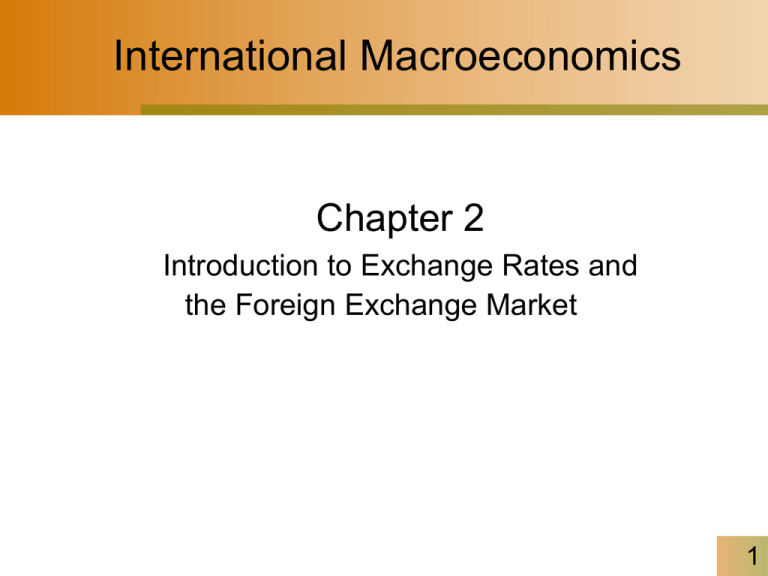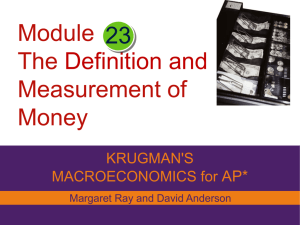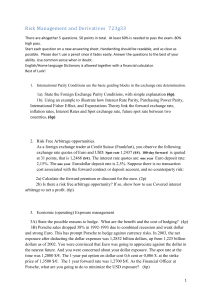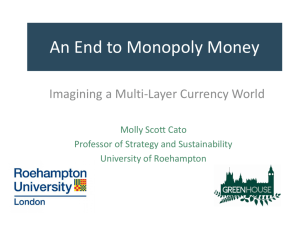Economics Principles and Applications - YSU
advertisement

International Macroeconomics Chapter 2 Introduction to Exchange Rates and the Foreign Exchange Market 1 Chapter Outline • The basics of exchange rates • Foreign exchange market • Arbitrage in foreign exchange market 2 The Basics of Exchange Rates • An exchange rate of a currency is the price of the currency expressed in terms of another currency. • Exchange rates quotations – Direct/Indirect • Pick a home currency (US$, for instance) • Direct quote – $1.1291/€1 • Indirect quote – €0.8857/$1 – American/European • American quote - $0.1567/ ¥1 • European quote – ¥6.3815/$1 – Yahoo Finance, oanda.com, etc. 3 The Basics of Exchange Rates (cont.) • Depreciation and Appreciation of Currencies – Depreciation (appreciation) is a decrease (increase) in the value of a currency relative to another currency. – $1.3124/€1 $1.2568/€1 $1.1291/€1 – Percentage change: E$/€ = 1.1291-1.2568 = -0.1277 % E$/€ = -0.1277/1.2568 = -0.1016 = -10.16% – Thus, the euro depreciated against the dollar by 10.16%. 4 The Basics of Exchange Rates (cont.) • Depreciation and Appreciation of Currencies – A depreciated (appreciated) currency means that imports are more (less) expensive and domestically produced goods and exports are less (more) expensive. – A depreciated (appreciated) currency lowers (raises) the price of exports relative to the price of imports. 5 The Basics of Exchange Rates (cont.) Exchange rate ($/£) 1.25 1.50 1.75 Price of sweater in $ 62.50 75.00 87.50 Price of a pair of jeans in $ 45.00 45.00 45.00 Relative price (Sweater/pair of jeans) 1.39 1.67 1.94 Note: The above calculations assume unchanged money prices of $45 per pair of jeans and £50 per sweater The Basics of Exchange Rates (cont.) • Effective exchange rates – Calculated based on the weighted-average of changes in a group of exchange rates of a currency (say ‘Home’ currency, typically the US dollar). – For a exchange rate, the weight is usually determined by the trade volume between two countries. – For example, 60% of US trade is with country 1 and 40% is with country 2. US$ appreciates 10% against 1 and depreciates 15% against 2. Hence, the change in the effective exchange rate of US$ is calculated as: 10%*60%+(-15%)*40% = 0%. Thus, effectively, US$ remains the same. – Check the Major Currency Index (MCI) at St. Louis Fed. 7 The Basics of Exchange Rates (cont.) Effective Exchange Rates In general, suppose there are N currencies in the basket, and Home’s trade with all N partners is: Trade = Trade1 + Trade2 + . . . + TradeN. Applying trade weights to the change of each bilateral exchange rate, the home country’s effective exchange rate (Eeffective) will change according to the following weighted average: Eeffective E1 Trade 1 E2 Trade 2 EN Trade N Eeffective E Trade E Trade E Trade 12N Trade - weighted average of bilateral nominal exchange rate changes 8 The Basics of Exchange Rates (cont.) Effective Exchange Rates 9 The Basics of Exchange Rates (cont.) There are two major types of exchange rate regimes— • Fixed (or pegged) exchange rates fluctuate in a narrow range (or not at all) against some base currency over a sustained period. Revaluations and devaluations may occur when the government intervenes in the foreign exchange market. • Floating (or flexible) exchange rates fluctuate as a result of market forces (demand/supply), and the government makes no attempt to fix it. Appreciations and depreciations occur continuously in real time trading. Terms: managed float, crawling peg, currency band, and dollarization. 10 The Basics of Exchange Rates (cont.) A Spectrum of Effective Rate Regimes This figure shows IMF classification of exchange rate regimes around the world for covers 192 economies in 2010. Regimes are ordered from the most rigidly fixed to the most freely floating. Seven countries use an ultrahard peg called a currency board, while 35 others have a hard peg. 11 The Basics of Exchange Rates (cont.) A Spectrum of Exchange Rate Regimes (continued) An additional 43 counties have bands, crawling pegs or bands, while 46 countries have exchange rates that either float freely, are managed floats are allowed to float within wide bands. 12 Foreign Exchange Market • The set of markets where foreign currencies and other assets are exchanged for domestic ones. – Institutions buy and sell deposits of currencies or other assets for investment purposes. • Recently, the daily volume of foreign exchange transactions has been more than $5 trillion – up from $500 billion in 1989. • Participants include commercial banks(other depository institutions), non-bank financial institutions, non-financial businesses, and central banks. 13 Foreign Exchange Market (cont.) Spot rates vs. Forward rates – Spot rates are the exchange rates at which currencies are traded immediately at the present. – Forward rates are the exchange rates agreed upon between two parties to trade currencies at a certain future time. 14 Dollar/Pound Spot and Forward Exchange Rates 1983–2011 Source: Datastream. Rates shown are 90-day forward exchange rates and spot exchange rates, at end of month. 15 Foreign Exchange Market (cont.) Other derivatives – • Foreign exchange swaps – Exchanges of loan principals and interest payments in different currencies • Futures contracts – a standardized contract to buy or sell a specified currency of standardized quality at a certain date in the future, at a specified price. – Forward contracts vs. Futures contracts • Options contracts (Call/Put) – A right given to the buyer to buy or sell a currency at a specified price for a standard amount on or before a specified future date . 16 Foreign Exchange Market (cont.) Derivatives allow investors to engage in hedging (risk avoiding) and speculation (risk taking) – • Hedging – Disney would like to hedge the exchange rate risk on its ¥10billion expected to be earned in Shanghai in one year. What would you suggest on how Disney should conduct the hedge? • Speculation – The current exchange rate between Chinese yuan and US$ is ¥6.4/$. If you expect that yuan is going to depreciate further in 3 months and wish to make a bet, you would sell yuan futures now. If your expectation bears out, you will make a profit; if not, your investment will be a total loss. 17 Foreign Exchange Market (cont.) • Factors that influence the return on assets determine the demand of those assets, including currency deposits. • Rate of return: the percentage change in value that an asset offers during a time period. – Real rate of return: inflation-adjusted rate of return • Risk and return – Inflation risk – Liquidity risk – Default risk – Maturity risk 18 Foreign Exchange Market (cont.) • We assume that risks of currency deposits in foreign exchange markets are the same, regardless of their currency denomination. • Rates of return that investors expect to earn are determined by - Interest rates that the assets will earn - Expectations about appreciation or depreciation 19 Foreign Exchange Market (cont.) • Suppose the interest rate on a dollar deposit is 2%. • Suppose the interest rate on a euro deposit is 4% • Is investment in a euro deposit more attractive than that in a dollar deposit? Suppose today the exchange rate is $1/€1, and the expected rate one year in the future is $0.97/€1. $100 can be exchanged today for €100. These €100 will yield €104 after one year. These €104 are expected to be worth $0.97/€1 x €104 = $100.88 in one year. The rate of return in terms of dollars from investing in euro deposits is ($100.88-$100)/$100 = 0.88%. 20 Foreign Exchange Market (cont.) • Analyze the dollar rate of return on euro deposits: [($100 / $1/€1) x (1+4%) x $0.97/€1]/100 – 1 = (1+4%) x (0.97-1)/1 + 4% = 4% + (-3%) + 4% x (-3%) = 0.88% • Considering the even smaller value of the multiplication of two small percentages, we decompose the dollar rate of return on euro deposits into two components: – The interest rate on euro deposits – The expected rate of appreciation of euro deposits R€ + (Ee$/€ - E$/€)/E$/€ = 4% + (-3%) = 1% 0.88% 21 Foreign Exchange Market (cont.) • Compare the rate of return on dollar deposits with that on euro deposits R$ - [R€ + (Ee$/€ - E$/€)/E$/€ ] = 2% - 1% = 1% • The investment in dollar deposits is more attractive. 22 Arbitrage in Foreign Exchange Market • Arbitrage: buying at a lower price and selling at a higher price for a profit. • Active trading and the increasing degree of integration in forex market imply that there are no significant arbitrage opportunities on currencies. 23 Arbitrage in Foreign Exchange Market (cont.) Arbitrage with three currencies: E£/$=0.6; E£/€=0.7; E€/$=1.0 No-arbitrage condition requires E£/$=E£/€*E€/$. In this example, however, E£/$=0.6 < E£/€*E€/$ =0.7*1.0=0.7. Thus, an arbitrage opportunity exists. Now, how to take advantage of it? Suppose you have one US$ and ignore transaction cost: 1. First, buy euro with your one US$: $1* E€/$=1*1= €1; 2. Next, sell the euro for pound: €1*E£/€=1*0.7=£0.7; 3. Lastly, sell the pound for US$: £0.7/E£/$=0.7/0.6=$1.17. Your arbitrage profit is 1.17-1=$0.17 or 0.17/1=17%. 24 Arbitrage in Foreign Exchange Market (cont.) • Interest Rate Parity (IRP) – the relationship between interest rates on currency deposits and foreign exchange rates. • If the US federal reserve raises interest rates relative to those of European Central Bank (ECB), US dollar would appreciate against the euro. Reversely, changes in the exchange rate between US dollar and euro may indicate market expectations of a change in interest rate policies. 25 Arbitrage in Foreign Exchange Market (cont.) • Covered Interest Parity (CIP) relates interest rates across countries and the rate of change between forward exchange rates and the spot exchange rate: i$ = i€ + (F$/€ - E$/€)/E$/€ where F$/€ is the forward exchange rate. • It says that rates of return on dollar deposits and “covered” foreign currency deposits are the same. – How could you earn a risk-free return in the foreign exchange markets if covered interest parity did not hold? – Covered positions using the forward rate involve little risk. Arbitrage in Foreign Exchange Market (cont.) Consider alternative one-year investments for $100,000: 1. Invest in the U.S. at i$. Future value = $100,000 × (1 + i$) 2. Trade your $ for £ at the spot rate, invest $100,000/E$/£ in Britain at i£ while eliminating any exchange rate risk by selling the future value of the British investment forward. F$/£ Future value = $100,000(1 + i£)× E$/£ Assuming these investments have the same risk (they probably do if they are short-term bank deposits), they must have the same future value (otherwise an arbitrage would exist). F$/£ (1 + i£) × = (1 + i$) E$/£ 27 Arbitrage in Foreign Exchange Market (cont.) F$/€ (1 + i€) × = (1 + i$) E$/€ Take natural logs on both sides of the above equation and rearrange, we get i$ = i€ + f$/€ - e$/€ - where f$/£ and e$/£ are the natural log terms of forward rate and spot rate, respectively. When forward premium (discount), i.e. (F$/€ - E$/€)/E$/€ is small, it is very close to (f$/€ - e$/€). In that case, i$ = i€ + (F$/€ - E$/€)/E$/€ Arbitrage in Foreign Exchange Market (cont.) • Uncovered Interest Parity (UIP) relates interest rates across countries and the expected rate of change in the spot exchange rate: E$e/ € 1 i$ 1 i€ E$ / € Dollar return on dollar deposits Expected dollar return on euro deposits 𝑒 where 𝐸$/€ is the expected exchange rate. Since it is expected not determined, traders face exchange rate risk under UIP. Arbitrage in Foreign Exchange Market (cont.) • Uncovered Interest Parity (UIP) is a no-arbitrage condition that describes an equilibrium in which investors are indifferent between the returns on unhedged interest-bearing bank deposits in two currencies. • If both CIP and UIP hold, the forward rate must equal 𝑒 the expected future spot rate, i.e. 𝐹$/€ = 𝐸$/€ . Consequently, investors are indifferent towards exchange rate risk, which makes them risk neutral. But, is it true? Arbitrage in Foreign Exchange Market (cont.) • Empirically, UIP doesn’t hold, especially in the short run, which means 𝑒 𝐸$/€ 𝐹$/€ −1≠ −1 𝐸$/€ 𝐸$/€ • Explanations Are investors rational? Are investors risk neutral? Are empirical tests appropriate? (endogeniety, non-stationary variables, time horizon, etc.)







